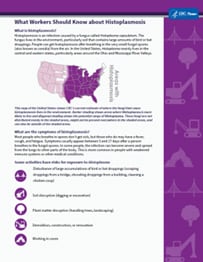Immune, Infectious, and Dermal Disease Prevention Program
The National Institute for Occupational Safety and Health (NIOSH) Immune, Infectious, and Dermal Disease Prevention Program works with partners in industry, labor, trade associations, professional organizations, and academia. The program focuses on these areas:
- Reducing immune abnormalities (including immune aspects of asthma) associated with workplace exposures.
- Reducing work-place skin disorders and exposures that result in disease.
- Identifying and reducing exposure and transmission of infectious diseases in the workplace.
- Conduct research to better understand the impact and basic mechanisms of work-place exposures on the immune system, including exposures to chemical, biological, or infectious agents.
- Improve surveillance and statistical modeling for hazard identification, exposure assessment, and risk characterization of chemicals absorbed through the skin that lead to immune or systemic toxicity (e.g., damage to internal organs).
- Identify and increase awareness of work-place immune and dermal health hazards through
- collaborations with NIOSH sector programs, contributions to field investigations and dissemination of research findings.
- Conduct investigations and provide evidence-based guidance on prevention measures for employers and workers to reduce transmission of infectious disease in the workplace.
- Publish Skin Notation (SK) Profiles, hazard warnings used worldwide, to alert workers and employers to the health risks of skin exposures to workplace chemicals.
- Updated a fact sheet on protecting workers from histoplasmosis, an infection caused by the Histoplasma fungus, which is often present in agricultural and construction environments.
- Published research on the systemic toxicity induced by dermal exposure to perfluoroalkyl substances (PFAS).
- Published research on the reduction of exposure to simulated respiratory aerosols using ventilation, physical distancing, and universal masking, which demonstrated that a layered mitigation approach composed of engineering and administrative controls remains important in reducing transmission in indoor spaces.
- Published research about the association of the abundant indoor yeast species Vishniacozyma victoriae in the homes of asthmatic and non-asthmatic children.
- Investigate the effects of dermal exposure to PFAS on the immune system using animal models.
- Conduct research on how exposure to disinfectants used during the COVID-19 pandemic affect the immune system.
- Investigate and publish research on how air purifiers can mitigate the spread of COVD-19 aerosols.
- Assist with planned updates to national guidelines for isolation precautions and prevention of infectious disease transmission in healthcare settings.
- Conduct studies to study the signs of disease involved in the immune response to the fungi Stachybotrys chartarum and Aspergillus versicolor exposure.

Mention of any company or product does not constitute endorsement by the National Institute for Occupational Safety and Health, Centers for Disease Control and Prevention
The Immune, Infectious, and Dermal Disease Prevention Program primarily focuses on hazard identification to prevent and minimize the effects of work-related dermal, infectious and immune diseases. This snapshot shows recent accomplishments and upcoming projects and activities.

To learn more, visit
www.cdc.gov/niosh/programs/idid
September 2022

